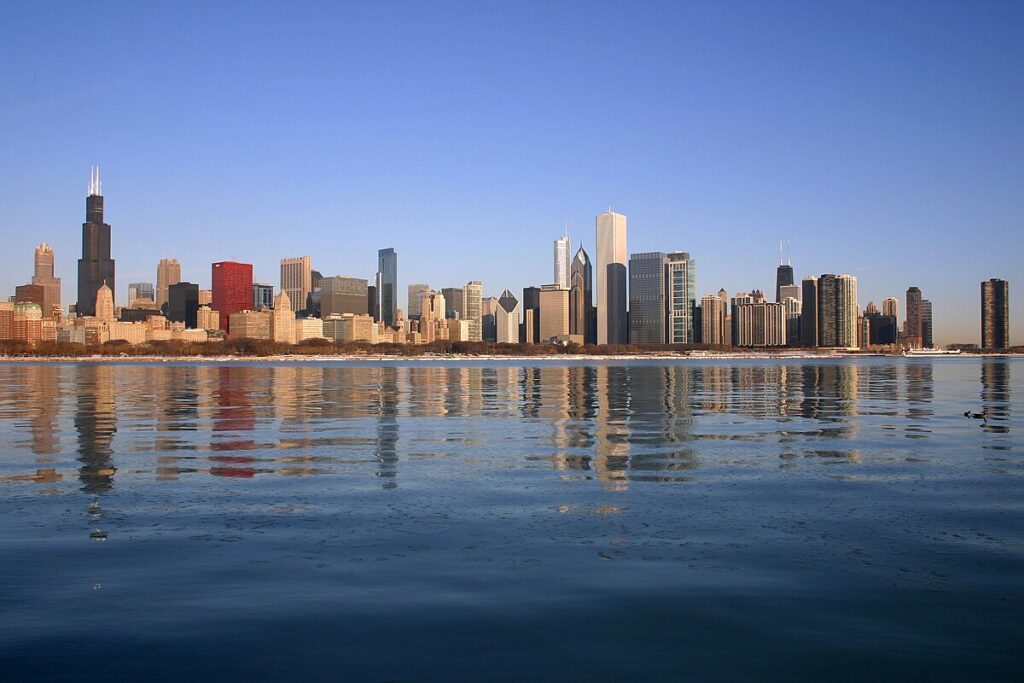
Moving to Chicago, Illinois: A Comprehensive Relocation Guide
Considering moving to Chicago, Illinois? This world-class city offers architecture, culture, and Midwest energy. With approximately 2.7 million residents in 2025 (metro 9.5 million+), Chicago combines urban sophistication with neighborhood character and America’s third-largest city.
Demographic Profile to Consider If Moving to Chicago:
Chicago’s 2025 city population is approximately 2.7 million residents, with the metro area exceeding 9.5 million. The median age is around 35 years, with incredibly diverse residents including professionals, immigrants, students, families, and artists. The population is approximately 33% White, 29% Hispanic, 29% Black or African American, 7% Asian. Chicago features 77 distinct neighborhoods from Loop’s downtown to Lincoln Park’s affluence to Pilsen’s Mexican heritage to Bronzeville’s historic African American community. The city attracts professionals seeking career opportunity, diverse culture, world-class amenities, and authentic urban living. Chicago appeals to those prioritizing career advancement, cultural diversity, architecture, food scene, and big-city energy with Midwest affordability and friendliness. The community balances explosive growth areas with historic neighborhoods and population challenges in some areas. Find trusted local services for moving, living, and working in Chicago.Chicago Relocation Directory
Cost of Living to Consider If Moving to Chicago:
Chicago offers moderate costs for a major metro, though rising. Median home values range from $280,000 to $550,000+ in 2025, varying dramatically by neighborhood from South/West Side affordability to North Side and downtown luxury. The median household income is approximately $65,000. Rental properties average $1,500 to $3,000+ monthly depending on neighborhood. Illinois’ state income tax is flat 4.95%. Property taxes are very high. Overall cost of living remains lower than coastal cities though increases with gentrification. Chicago attracts diverse income levels from artists to executives. Housing costs vary enormously by neighborhood creating options. The combination of career opportunities, culture, and relative coastal affordability drives migration despite challenges.
Economy and Job Market:
Chicago’s economy is diverse and robust, centered on finance, professional services, healthcare, manufacturing, technology, and transportation. Major employers include CME Group, United Airlines, Boeing (headquarters), Walgreens, McDonald’s (headquarters), numerous hospitals including Northwestern Medicine and Rush University Medical Center, universities, and thousands of companies. The financial sector thrives in the Loop. O’Hare and Midway airports employ tens of thousands. Manufacturing and logistics capitalize on transportation infrastructure. The technology sector grows rapidly. Typical industries span all sectors from finance to healthcare to manufacturing to professional services. The diverse economy provides opportunities across skill levels. Chicago offers Midwest’s most career opportunities and upward mobility.
Education:
Chicago Public Schools operates the nation’s third-largest district with dramatic quality variation from selective enrollment schools (excellent) to struggling neighborhood schools requiring extensive research. The University of Chicago, Northwestern University (Evanston/Chicago), DePaul University, Loyola University Chicago, Illinois Institute of Technology, and numerous colleges create academic presence. The concentration of universities creates intellectual atmosphere and graduates talent.
Recreation and Lifestyle:
Chicago offers world-class attractions including Millennium Park (Cloud Gate “Bean”), Art Institute of Chicago, Navy Pier, 26 miles of lakefront with beaches, Museum Campus (Field Museum, Shedd Aquarium, Adler Planetarium), Magnificent Mile shopping, deep-dish pizza, and 77 diverse neighborhoods each with unique character. Professional sports include Cubs (Wrigley Field), White Sox, Bears, Bulls, Blackhawks. The architecture including Willis Tower and riverfront skyscrapers creates iconic skyline. Festivals year-round celebrate culture, food, music. The restaurant scene rivals any city. The lakefront provides recreation paradise. The lifestyle emphasizes neighborhoods, public transit or biking (Chicago very bikeable), four-season activities, ethnic diversity creating authentic global food, and urban energy with Midwest friendliness. The brutal winters and hot humid summers create distinct seasons. The community values neighborhoods, sports passion (Cubs/Sox divide city), architecture, diverse culture, and work-life balance. Living in Chicago means accepting harsh winters, high property taxes, some crime concerns requiring neighborhood research, and choosing urban energy over suburban space while enjoying world-class culture, career opportunity, and authentic city living with Midwest character and coastal affordability.
Healthcare and Services:
Chicago residents access world-class healthcare through Northwestern Memorial Hospital, Rush University Medical Center, University of Chicago Medicine, Advocate Health Care, and extensive medical facilities. The healthcare infrastructure is exceptional with specialized care in all disciplines.
Transportation:
Chicago benefits from the CTA (Chicago Transit Authority) operating extensive L train and bus system, Metra commuter rail serving suburbs, Interstate 90/94, and various expressways. O’Hare and Midway airports provide extensive flights. Many residents rely on public transit. Bike infrastructure improves continuously. Some neighborhoods offer excellent walkability. Traffic congestion is significant during rush hours. Typical commute times vary dramatically by mode and location.
Conclusion:
Moving to Chicago in 2025 offers world-class city living with architecture, culture, and career opportunity. The city’s combination of diverse neighborhoods, lakefront beauty, and Midwest character makes it ideal for professionals, diverse families, and urban enthusiasts seeking America’s most livable big city where skyscrapers meet neighborhoods and career advancement combines with authentic urban culture in the city that works.

